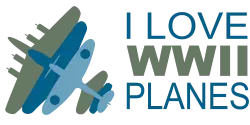Puff, the Magic Dragon – the AC-47 Gunship
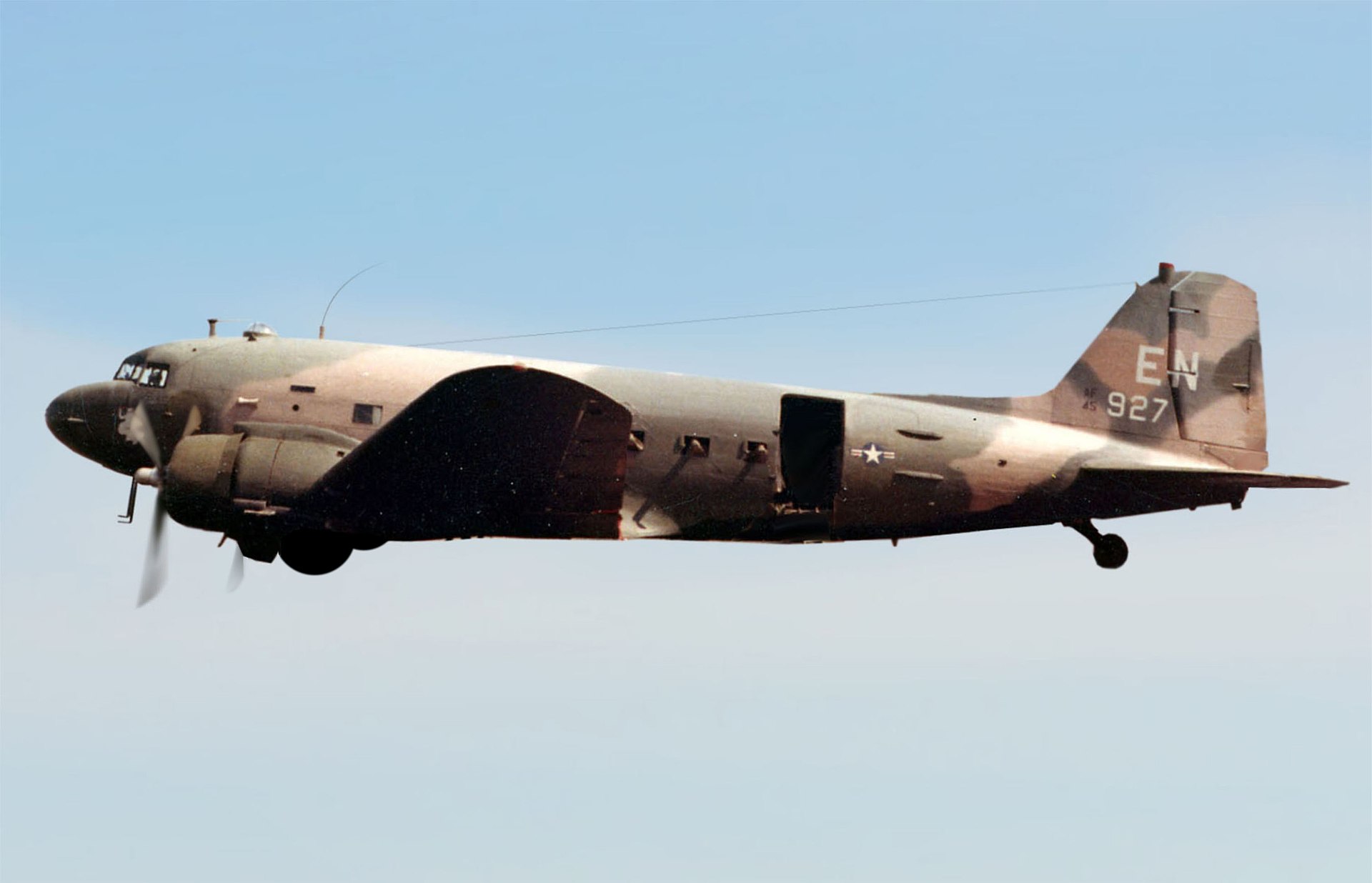
The AC-47 Spooky was the first in a line of a new type of aircraft called gunships, that were designed to fly at low altitude and speeds, providing accurate and intense firepower against targets on the ground. The platform to carry this firepower was the Douglas C-47 Skytrain, an ageing WWII era transport aircraft that was completely obsolete, but found a new lease of life in the role of a gunship.
The AC-47s first engaged in combat in 1965 over Vietnam, but the idea for a sideways firing aircraft goes back to the 1920s, when a pilot suggested attaching sideways firing weapons to an aircraft.
The aircraft would then perform a pylon turn, where an aircraft flies in a banked circle around a fixed point on the ground, firing its weapons as it did so.
This gave the aircraft far more time over the target than a strafing run. The pilot, Army 1st Lt. Fred Nelson actually successfully tested his idea. As with many radical ideas though, few saw the use of such an aircraft.
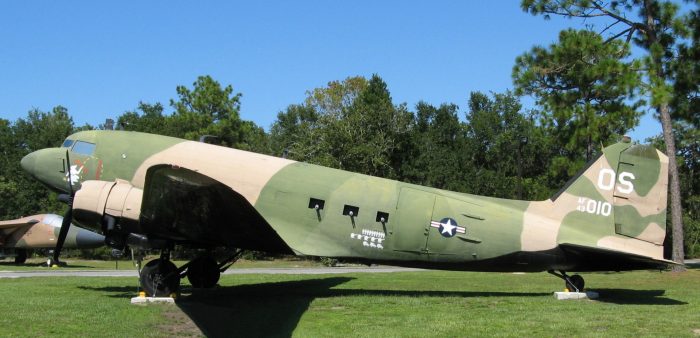
The idea resurfaced during WWII, but was again rejected, and wouldn’t be taken seriously until the 1960s. Tests were performed in 1964 on a Convair C-131 transport aircraft modified to carry a single M134 facing out the left side of the aircraft.
To begin with, a simple crosshair drawn on the cockpit window with a grease pencil proved surprisingly adequate for the pilot to aim with. However due to a lack of funding, the testing ended.
Meanwhile in Vietnam, the many small villages and settlements in the jungles were constantly under attack from VC forces, often at night.
To provide illumination for the fighting below, the US were using C-47 ‘flareships’ to drop flares over the target. Captain Ron W. Terry, part of a US Air Force team reviewing air operations in the region, had taken note of the usefulness of the circling C-47 flareships, but also the desperate need for more firepower to repel these attacks. Under the direction of Terry, the gunship programme was re-established.

By October 1964, the programme had acquired a C-47 that was ready for modifications and testing. After successful tests with the C-47 back in the US, the team shipped out for South Vietnam. Arriving on December 2nd 1964, the team set about modifying two C-47s to gunship standards. The two aircraft were ready by December 15th.
The C-47s were rather crudely fitted with three M134 Miniguns in SUU-11/A pods pointing out the left side. These streamlined pods were originally designed to hang beneath the wings of aircraft.
The streamlining casings were removed, and a locally fabricated mount was made to secure it to the aircraft. For the pilot to aim the guns, a MK 20 Mod 4 gunsight from the Douglas Skyraider was mounted to the left cockpit window.
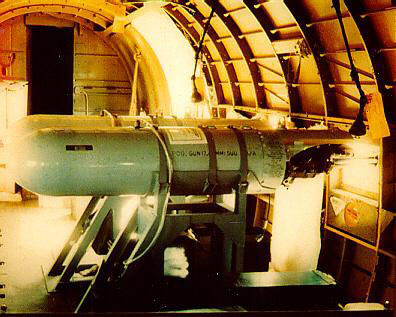
Controls were added to the pilots column that allowed selective fire between individual or all guns. The aircraft was outfitted with extra radios to communicate with those on the ground, and 45 flares to illuminate the target below. These would be thrown by hand out the cargo door. Additionally, 24,000 rounds of ammunition were carried.
7 crew members were on board, with the usual pilot, copilot, navigator, flight engineer and loadmaster, but the AC-47s also brought 2 gunners to maintain the weapons in case of jams or other issues.
At the time the M134 Minigun was a new weapon, with a unique multi-barrel electronically powered rotary operation that enabled rates of fire previously unheard of. It had an optional fire rate of 3,000 or 6,000 rounds per minute. Combined, the three miniguns onboard could fire 18,000 rounds per minute.
It was given the official designation of FC-47 for Fighter/Cargo, although this would change to AC-47 (Attack/Cargo) in 1965 after the protest of fighter pilots who didn’t want to be associated with a lumbering relic.
The AC-47 is perhaps most remembered for its unique names, most famously ‘Spooky’ and ‘Puff, the Magic Dragon’. Spooky is suggested to have come from its mystical appearance out of the darkness at night, letting loose its deadly weaponry onto its enemies. It also may have come from a pilot jokingly referring to the aircraft as a ‘spooky Gooney Bird’.

Puff, the Magic Dragon was a name that stemmed from a Stars and Stripes reporter who witnessed a Spooky in action, referring to it as fire breathing dragon. Due to the popular 1963 song Puff, the Magic Dragon, the connection was quickly made and the name stuck.
The aircraft began combat trials immediately, with its first notable engagement on the night of December 23 1964. 37 minutes after an air support request was received from a Special Forces outpost under VC attack, a Spooky arrived overhead and unleashed its devastating firepower. Over 4,000 rounds later, and the VC withdrew.
The aircraft then repelled another VC attack 20 miles away at another outpost before returning to base. The C-47 airframe had a good service range, meaning it could loiter above a target for hours on end. This flight time was used in February 1965 when a Spooky gunship circled a VC position for four hours and fired over 20,000 rounds.
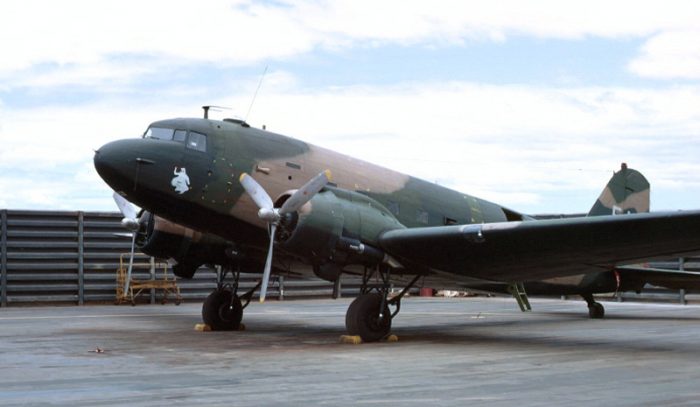
With these continuous early successes, the Air Force requested more Spooky conversions in 1965. Due to the scarcity of the Miniguns, the next few aircraft were instead fitted with ten .30 caliber Browing machine guns, however even with this amount, they still couldn’t match anyway near the output of three Miniguns. Eventually more Miniguns would arrive, and would once again be their primary armament.
Spookys continued to wage their devastating war against the enemy, defending countless villages, fortifications and outposts from VC attacks and targeting enemy held territory and supply convoys.
This carried on into 1966, where in October an AC-47 expended its 45 flares and 24,000 rounds of ammunition defending an outpost in Kien Phong Province. It returned to base, refuelled, rearmed and returned to fire off another 19,500 rounds.

In 1966, the fleet of Spookys had flown 5,584 missions and fired 13.6 million rounds and 81,700 flares. Records show that no friendly outpost or village was ever lost when under the protection of a Spooky gunship. The aircraft also massively affected enemy morale, as reports state entire attacks being called off at the sound of an approaching Spooky, or upon the drop of its first flare.
In 1969 an 82 mm mortar struck a Spooky, causing significant damage to the aircraft, and severely injuring loadmaster John Lee Levitow while he was handling an armed flare.
Despite having 40 injuries, Levitow managed to crawl to the flare and throw it out the cargo door, where it exploded just outside the aircraft. The aircraft and its crew managed to make it back to base. For his bravery while wounded, Levitow was awarded the Medal of Honor.
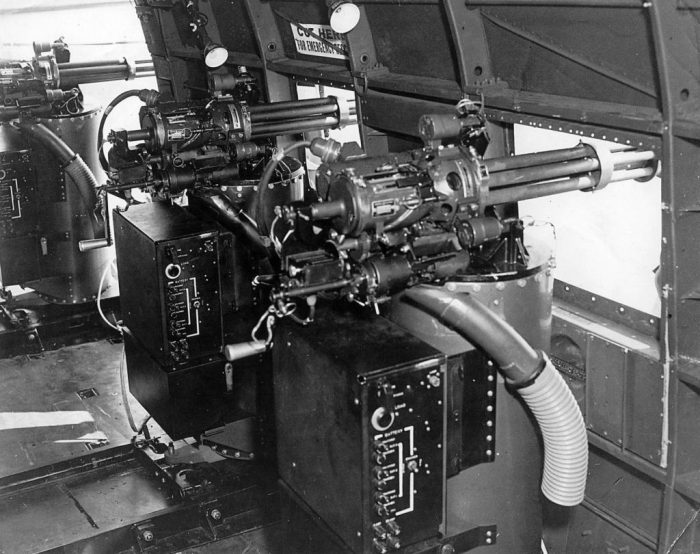
Naturally the Air Force looked for a replacement for the AC-47, which would be the Lockheed C-130 transport aircraft.
Using the lessons learnt from the AC-47 gunship, the AC-130 would be an entire ground up adaptation of the C-130, with much more advanced avionics, fire control and capabilities. It would be armed with two 20 mm Vulcan cannons, one 40 mm Bofors cannon, and a 105 mm howitzer. The AC-130s would initially serve alongside the AC-47s, but they would eventually entirely replace them, and are still in service with the US today.
Another Article From Us: Awesome Aircraft From WWII
With the arrival of the AC-130 in numbers, the US began transferring the AC-47s to friendly nations in the area, including South Vietnam and Cambodia, the latter of which still operates them. The AC-47 is an amazing example of outdated equipment being revitalised into a new role, one that only it could perform. After the many thousands of lives it saved, the AC-47, Spooky, Puff, the Magic Dragon, will go down as a legend of the Vietnam war.
